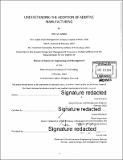| dc.contributor.advisor | James Utterback. | en_US |
| dc.contributor.author | Garza, Jose M. (Jose Manuel Garza Estrada) | en_US |
| dc.contributor.other | Massachusetts Institute of Technology. Engineering Systems Division. | en_US |
| dc.date.accessioned | 2017-08-01T13:14:51Z | |
| dc.date.available | 2017-08-01T13:14:51Z | |
| dc.date.copyright | 2016 | en_US |
| dc.date.issued | 2016 | en_US |
| dc.identifier.uri | http://hdl.handle.net/1721.1/110892 | |
| dc.description | Thesis: S.M. in Engineering and Management, Massachusetts Institute of Technology, School of Engineering, System Design and Management Program, 2016. | en_US |
| dc.description | Cataloged from PDF version of thesis. | en_US |
| dc.description | Includes bibliographical references (pages 55-56). | en_US |
| dc.description.abstract | Additive Manufacturing (AM) -commonly known as 3d printing - is experiencing an upward trend as measured by a number of metrics, such as patent filing and number of company entries. The number of companies manufacturing hardware, software and materials serving both consumer and industrial segments of this industry has increased over recent years. This technology has radically changed how companies, designers and consumers in general go about prototyping their ideas. AM has also impacted low-volume manufacturing by allowing the production of small batches of products with all the advantages and flexibility the technology confers. Because the industry is still in its fluid phase, a high level of activity and significant changes are still to come. Employing Diffusion of Innovation theory by E.M. Rogers [1] which proposes the use of five factors or dimensions to assess the diffusion speed: relative advantage, compatibility, complexity, triability and observability; the study followed a two-pronged methodology. First I conducted semi-structured interviews and observational analysis; then, I analyzed technological developments, patent activity and firm entry. This study uncovers that 3d-printing something without observing technical requirements is quite easy. But 3d-printing a product that complies with a set of product requirements and specifications, so that the component can then be used in the context of a larger assembly or specific use, is quite another story. Based on observational data this thesis describes the vicissitudes of designing, selecting the printer, setting up the printer's parameters and ultimately printing a component, and thus demonstrates a perspective of the adoptability of this technology. | en_US |
| dc.description.statementofresponsibility | by Jose M. Garza. | en_US |
| dc.format.extent | 57 pages | en_US |
| dc.language.iso | eng | en_US |
| dc.publisher | Massachusetts Institute of Technology | en_US |
| dc.rights | MIT theses are protected by copyright. They may be viewed, downloaded, or printed from this source but further reproduction or distribution in any format is prohibited without written permission. | en_US |
| dc.rights.uri | http://dspace.mit.edu/handle/1721.1/7582 | en_US |
| dc.subject | System Design and Management Program. | en_US |
| dc.subject | Engineering Systems Division. | en_US |
| dc.title | Understanding the adoption of additive manufacturing | en_US |
| dc.type | Thesis | en_US |
| dc.description.degree | S.M. in Engineering and Management | en_US |
| dc.contributor.department | System Design and Management Program. | en_US |
| dc.identifier.oclc | 994683796 | en_US |
